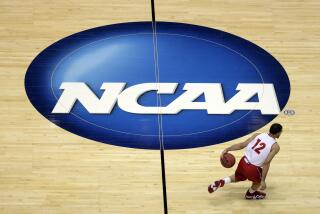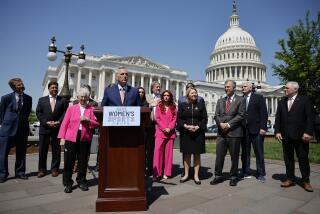NCAA to Crack Down on ‘Hostile’ Nicknames
The National Collegiate Athletic Assn. will ban the use of 18 Native American nicknames and mascots it considers “hostile or abusive” during its postseason tournaments beginning early next year, the organization announced Friday.
The move drew praise from groups that oppose such depictions but stirred controversy with a banned list that includes the Florida State Seminoles, the Illinois Fighting Illini and the Utah Utes, while granting exceptions to the San Diego State Aztecs and Cal State Stanislaus Warriors, among others.
“That’s a start,” said Cindy La Marr, former president of the National Indian Education Assn. and executive director of Capitol Area Indian Resources in Sacramento. She also has served on the steering committee of the California-based Alliance Against Racial Mascots.
“The whole reason behind it is, it harms our children,” La Marr said, citing not only stereotypes and caricatures but also the nicknames themselves.
“It’s different if it’s a city school or street. A sports team creates a division because one team wins and one team loses.”
But T.K. Wetherell, Florida State’s president, called the decision “outrageous and insulting,” citing a resolution by the Tribal Council of the Seminole Tribe of Florida in support of the school’s use of the nickname and symbols, which include Chief Osceola, who gallops onto the football field on horseback and plants a burning spear in the turf before home games.
“The rules, as we understand them, would have us cover the Seminole name and symbol as if we were embarrassed, and any committee that would think that is a proper and respectful treatment of Native Americans should be ashamed,” Wetherell said in a statement.
Max Osceola, a member of the tribal council, said: “Is the NCAA going to make Notre Dame go ask every Irishman if it’s OK to use the name Fighting Irish?”
San Diego State, which in recent years replaced its Monty Montezuma mascot and has worked to make its depiction of Aztecs historically accurate, successfully argued in part that an Aztec was not an American Indian.
“One, the Aztecs are not a North American culture, but a culture that was based in what is now Mexico,” said Jack Beresford, a university spokesman. “Second, we went through a pretty exhaustive process, a comprehensive review of our logos that were deemed offensive, and replaced Monty Montezuma with a new mascot, consulting the community and experts in Aztec culture to ensure it was historically accurate and culturally appropriate.”
NCAA spokesman Erik Christianson said the organization “accepted the findings from SDSU that it could not find any organized tribe or group related to Aztecs.
“The institution reviewed the issue both here in the United States and in Mexico, where the Aztecs first originated,” Christianson said.
The Cal State Stanislaus Warriors were not subject to the postseason ban because in recent years the school took the Indian head emblem off its basketball court and jerseys and changed its mascot several times, most recently to a mythical Trojan figure, Athletic Director Milton Richards said.
Among other schools that are not subject to the ban is North Carolina Pembroke, which uses the nickname Braves but was founded in part for Lumbee Indians in the area and has a high population of American Indian students.
The decision to enforce a limited ban was made by the NCAA Executive Committee, a group made up of university presidents and chancellors.
“Colleges and universities may adopt any mascot that they wish, as that is an institutional matter,” said Walter Harrison, chairman of the committee and president of the University of Hartford.
“But as a national association, we believe that mascots, nicknames or images deemed hostile or abusive in terms of race, ethnicity or national origin should not be visible at the championship events that we control.”
The NCAA ban, which is subject to appeal by individual schools, is to take effect in February. It will not cover regular-season competition or major college football’s bowl championship series, which is governed independently.
However, NCAA President Myles Brand said he hoped the BCS would follow the NCAA’s lead.
“We’re trying to send a message very strongly that we do not think these kind of mascots are appropriate,” Brand said.
The decision to limit the ban to NCAA-sponsored postseason competition is intended in part to protect the NCAA from litigation.
“As for lawsuits, I don’t mean to sound too flip about this, but everyone has recourse through the courts,” Brand said. “They certainly could try if they want, but we think this is a very reasoned and solid approach that governs those things we can control, and we would be prepared to defend that if cases were brought against us.”
As a postseason-only ban, its greatest immediate effect might be in terms of public discourse. Many teams with Native American mascots use them only at home games, in part because of potential controversy. During the Illinois men’s basketball team’s run to the Final Four last spring, the school’s Chief Illiniwek did not go to any postseason games.
The NCAA said it also would ban schools on the list from serving as hosts for postseason competition, a financially punitive move that Brand compared to the NCAA’s position on the Confederate flag issue of recent years.
Schools such as Utah that already are scheduled to conduct such events -- the school will be the site of first- and second-round games next March in the NCAA men’s basketball tournament -- must remove references to their nicknames and logos that are deemed offensive for the competition, the NCAA said.
Because the court at Utah’s Huntsman Center bears a black “U” and not its “drum and feather” logo, school officials expect it to be reasonably easy to comply.
“We were kind of surprised,” spokesman Mike Lageschulte said. “The Utes are an actual Indian tribe and we’ve had their blessing. It’s never been an issue.”
Effective in August 2008, the ban also will apply to the uniforms of cheerleaders, dance teams and band members at NCAA championship sites.
The use of Native American nicknames and mascots has been an issue for several decades, and in 2001, the U.S. Commission on Civil Rights called for an end to the use of Native American images and team names by non-Native American schools.
Stanford, which used the nickname Indians until 1972, was one of the first schools to change. Its teams are now known as the Cardinal, after the school color. St. John’s University in New York changed its nickname from Redmen to Red Storm, and the Marquette Warriors are now the Golden Eagles.
The National Football League’s Washington Redskins have faced legal challenges to their nickname, and baseball’s Atlanta Braves and Cleveland Indians have faced criticism.
“I do not believe the NCAA’s resolution will have an immediate impact on our situation,” said Bob DiBiasio, vice president for public relations for the Indians.
“Most people are aware of the history behind our team, being named in honor of Louis Francis Sockalexis. That legacy lives on since 1915. We do not have any plans to change at this time.”
Sockalexis played for the then-Cleveland Spiders in 1897-99. He was a Penobscot Indian from Old Town, Maine. He was the first American Indian to play major league baseball.
In 1997, the Los Angeles Unified School Board discontinued the use of American Indian symbols and mascots, a ruling that affected the University High Warriors and Gardena High Mohicans, among others.
A legislative attempt to ban the use of “Redskins” in California schools failed last year when Gov. Arnold Schwarzenegger vetoed a bill, saying the issue should be decided locally.
A similar bill sponsored by Assemblywoman Jackie Goldberg (D-Los Angeles) has passed the Assembly and is awaiting a vote in the Senate.
The bill would stop Calaveras High, Chowchilla Union High, Colusa High, Gustine High and Tulare Union High from using the nickname.
“When I asked people from the Native American community which one is the most egregious, without looking at each other they said, ‘Redskins.’ That was not tough for them,” Goldberg said. “I’d prefer nicknames were not for living people. I prefer colors, flowers, animals, that’s my own personal preference.”
Yet people with no ties to Indian heritage develop very strong ties to images of mascots from their school days.
“I met a young white blond with blue eyes and she said, ‘I’m a third-generation Redskin,’ ” Goldberg said. “My jaw dropped.”
“As far as I’m concerned, 30 years is too long. I’m very proud of the decision the NCAA made. If it’s offensive, we shouldn’t allow it. It’s not about sport, it’s not about spirit, it’s about human dignity.”
Times staff writers Tim Brown, Ben Bolch and Sam Farmer contributed to this report.
*
(BEGIN TEXT OF INFOBOX)
Mascots deemed offensive
The NCAA has prohibited 18 colleges and universities that “continue to use Native American imagery or references” from displaying their nicknames, logos or mascots at postseason games. The schools are:
Alcorn State University (Braves)
Central Michigan University (Chippewas)
Catawba College (Indians)
Florida State University (Seminoles)
Midwestern State University (Indians)
University of Utah (Utes)
Indiana University-Pennsylvania (Indians)
Carthage College (Redmen)
Bradley University (Braves)
Arkansas State University (Indians)
Chowan College (Braves)
University of Illinois (Illini)
University of Louisiana-Monroe (Indians)
McMurry University (Indians)
Mississippi College (Choctaws)
Newberry College (Indians)
University of North Dakota (Fighting Sioux)
Southeastern Oklahoma State University (Savages)
Source: National Collegiate Athletic Assn.
More to Read
Go beyond the scoreboard
Get the latest on L.A.'s teams in the daily Sports Report newsletter.
You may occasionally receive promotional content from the Los Angeles Times.










